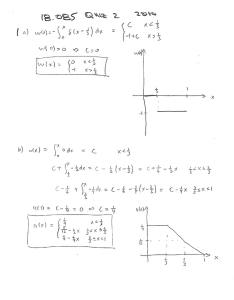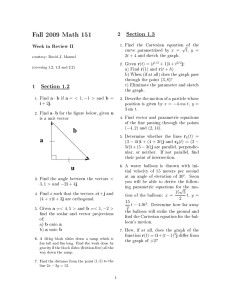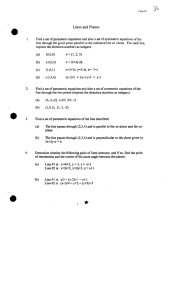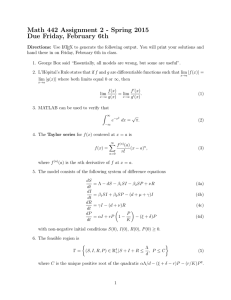SECOND-ORDER ESTIMATES FOR BOUNDARY BLOWUP SOLUTIONS OF SPECIAL ELLIPTIC EQUATIONS
advertisement
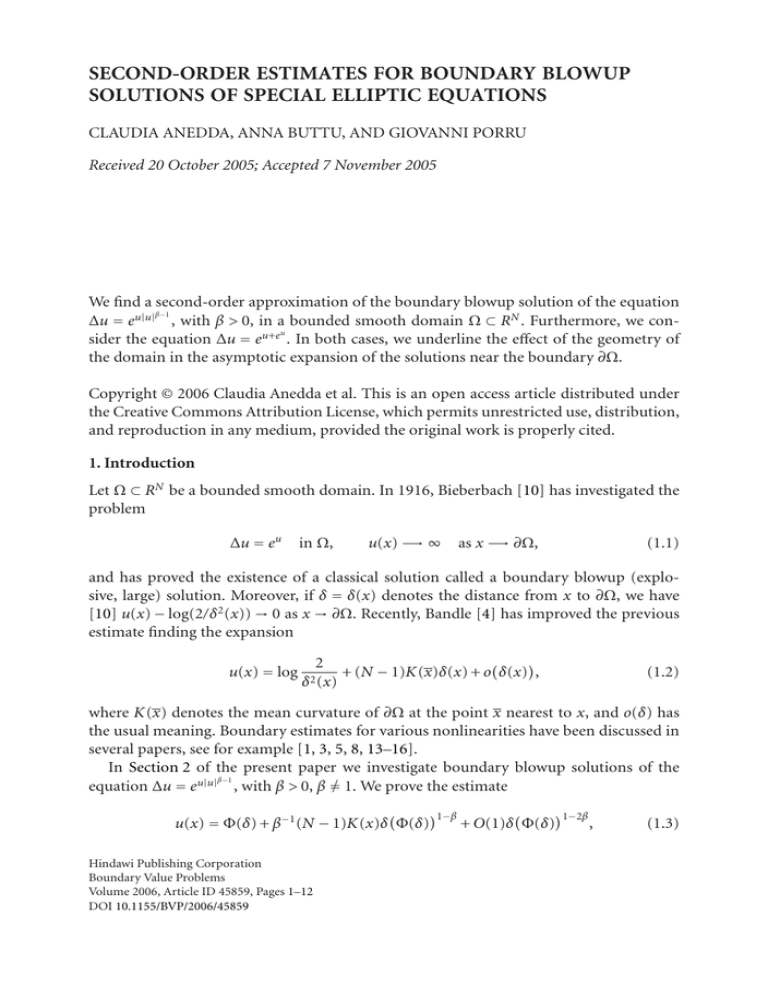
SECOND-ORDER ESTIMATES FOR BOUNDARY BLOWUP
SOLUTIONS OF SPECIAL ELLIPTIC EQUATIONS
CLAUDIA ANEDDA, ANNA BUTTU, AND GIOVANNI PORRU
Received 20 October 2005; Accepted 7 November 2005
We find a second-order approximation of the boundary blowup solution of the equation
β−1
Δu = eu|u| , with β > 0, in a bounded smooth domain Ω ⊂ RN . Furthermore, we conu
sider the equation Δu = eu+e . In both cases, we underline the effect of the geometry of
the domain in the asymptotic expansion of the solutions near the boundary ∂Ω.
Copyright © 2006 Claudia Anedda et al. This is an open access article distributed under
the Creative Commons Attribution License, which permits unrestricted use, distribution,
and reproduction in any medium, provided the original work is properly cited.
1. Introduction
Let Ω ⊂ RN be a bounded smooth domain. In 1916, Bieberbach [10] has investigated the
problem
Δu = eu
in Ω,
u(x) −→ ∞ as x −→ ∂Ω,
(1.1)
and has proved the existence of a classical solution called a boundary blowup (explosive, large) solution. Moreover, if δ = δ(x) denotes the distance from x to ∂Ω, we have
[10] u(x) − log(2/δ 2 (x)) → 0 as x → ∂Ω. Recently, Bandle [4] has improved the previous
estimate finding the expansion
u(x) = log
2
+ (N − 1)K(x)δ(x) + o δ(x) ,
δ 2 (x)
(1.2)
where K(x) denotes the mean curvature of ∂Ω at the point x nearest to x, and o(δ) has
the usual meaning. Boundary estimates for various nonlinearities have been discussed in
several papers, see for example [1, 3, 5, 8, 13–16].
In Section 2 of the present paper we investigate boundary blowup solutions of the
β−1
equation Δu = eu|u| , with β > 0, β = 1. We prove the estimate
u(x) = Φ(δ) + β−1 (N − 1)K(x)δ Φ(δ)
Hindawi Publishing Corporation
Boundary Value Problems
Volume 2006, Article ID 45859, Pages 1–12
DOI 10.1155/BVP/2006/45859
1−β
+ O(1)δ Φ(δ)
1−2β
,
(1.3)
2
Second-order estimates
where Φ(δ) is defined by the equation
∞
Φ(s)
2F(t)
−1/2
= s,
F(t) =
t
β−1
−∞
eτ |τ | dτ,
(1.4)
K(x) is the mean curvature of the surface {x ∈ Ω : δ(x) = constant}, and O(1) denotes a
bounded quantity.
u
In Section 3 we consider boundary blowup solutions of the equation Δu = eu+e . We
find the estimate
u(x) = Ψ(δ) + (N − 1)K(x)e−Ψ(δ) δ + O(1)e−2Ψ(δ) δ,
(1.5)
where Ψ is defined by the equation
∞
Ψ(s)
t
2ee − 2
−1/2
dt = s.
(1.6)
In this paper, the distance function δ = δ(x) plays an important role. Recall that if Ω
is smooth then also δ(x) is smooth for x near to ∂Ω, and [12]
N
δxi δxi = 1,
−
i =1
N
δxi xi = (N − 1)K = H,
(1.7)
i=1
where K = K(x) is the mean curvature of the surface {x ∈ Ω : δ(x) = constant}.
The effect of the geometry of the domain in the behaviour of boundary blowup solutions for special equations has been observed in various papers, see for example, [2, 7, 9,
11].
β−1
2. The equation Δu = eu|u|
In what follows we denote with O(1) a bounded quantity.
β−1
Lemma 2.1. Let β > 0, f (s) = es|s| , F(s) =
F(s) f (s) f (s)
s
−∞
−2
f (t)dt. Then
= 1 + O(1)s−β .
(2.1)
Proof. For s > 0 we have
F(s) f (s) f (s)
−2
−2
−2 s
= f (s) f (s) F(0) + f (s) f (s)
f (t)dt
0
s
s
β
β
β
β
β
= βe−s sβ−1 F(0) + e−s
et βt β−1 dt + βe−s
et sβ−1 − t β−1 dt
0
0
s
β
β
β
β
= βe−s sβ−1 F(0) + 1 − e−s + βe−s
et sβ−1 − t β−1 dt.
0
(2.2)
We have
lim sβ βe−s sβ−1 F(0) = 0,
β
s→∞
lim sβ e−s = 0.
β
s→∞
(2.3)
Claudia Anedda et al. 3
Moreover, using de l’Hôpital’s rule we find
s
β et s2β−1 − sβ t β−1 dt
lim 0
= lim
s→∞
s→∞
e sβ
β
s
(2β − 1)sβ−1 − βt β−1 dt
e sβ
s β
β
(β − 1)es sβ−1 + 0 et (2β − 1)(β − 1)sβ−2 dt
= lim
s→∞
βesβ sβ−1
0e
tβ
s
β
β−1
et dt
=
+ (2β − 1)(β − 1) lim 0 sβ
s
→∞
β
βe s
β−1
β−1
1
=
=
+ (2β − 1)(β − 1) lim .
β
s
→∞
β
β
β 1 + βs
(2.4)
The lemma follows.
Remark 2.2. If β = 1, we have F(s) f (s)( f (s))−2 = 1. We do not care of this special case
because it has been discussed in [2].
Lemma 2.3. Let Φ = Φ(δ) be defined by
∞
Φ(δ)
2F(t)
−1/2
dt = δ,
F(t) =
t
−∞
β−1
f (τ)dτ, f (τ) = eτ |τ | .
(2.5)
Then
−β −Φ (δ) = 1 + O(1) Φ(δ)
δ f Φ(δ) .
(2.6)
Proof. By the (trivial) relation
−1 + 2 1 + O(1)s−β = 1 + O(1)s−β ,
(2.7)
−2
−1 + 2F(s) f (s) f (s)
= 1 + O(1)s−β .
(2.8)
using (2.1) we have
Multiplying by (2F(s))−1/2 we find
−1/2 1/2 −2 −1/2
−1/2 −β
− 2F(s)
+ 2F(s)
f (s) f (s)
= 2F(s)
+ O(1) 2F(s)
s ,
1/2 −1 −1/2
−1/2 −β
− 2F(s)
f (s)
= 2F(s)
+ O(1) 2F(s)
s .
(2.9)
Integrating on (s, ∞) we get
2F(s)
1/2 f (s)
−1
=
∞
s
2F(t)
−1/2
∞
dt + O(1)
s
2F(t)
−1/2
t −β dt.
(2.10)
4
Second-order estimates
Using de l’Hôpital’s rule we find
s−β
∞
s
lim ∞ s→∞
s
2F(t)
2F(t)
−1/2
−1/2
dt
2F(s)
= lim
−1/2
s−β + βs−β−1
s→∞
t −β dt
= 1 + lim
β
s
s→∞
= 1 + lim
s→∞
2F(s)
∞
2F(t)
−1/2
−1/2
s 2F(s)
−β
1 − s 2F(s)
−1
∞
−1/2
2F(t)
s
−1/2
dt
s−β
dt
(2.11)
f (s)
= 1.
In the last step we have used the limit
lim
s→∞
s f (s)
= ∞,
F(s)
(2.12)
which can be proved easily with de l’Hôpital’s rule. Using (2.11), (2.10) can be rewritten
as
2F(s)
1/2 f (s)
−1
=
∞
2F(t)
s
−1/2
dt + O(1)s−β
∞
s
2F(t)
−1/2
dt.
(2.13)
Putting s = Φ(δ) and using the equation −Φ (δ) = (2F(Φ(δ)))1/2 , the lemma follows.
Theorem 2.4. Let Ω be a bounded smooth domain in RN , N ≥ 2, and let β > 0, β = 1. If
β−1
u(x) is a boundary blowup solution of Δu = eu|u| in Ω, then
u(x) = Φ(δ) + β−1 Hδ Φ(δ)
1−β
+ O(1)δ Φ(δ)
1−2β
,
(2.14)
where Φ(δ) is defined as in (2.5), δ = δ(x) is the distance from x to ∂Ω and H is defined by
(1.7).
Proof. We look for a super-solution of the form
w(x) = Φ(δ) + β−1 Hδ Φ(δ)
1−β
+ αδ Φ(δ)
1−2β
,
(2.15)
where α is a positive constant to be determined. Denoting by differentiation with respect
to δ, we have
wxi = Φ (δ)δxi + β−1 Hxi δ Φ(δ)
1−β
+ β−1 H δ Φ(δ)
1−β δxi + α δ Φ(δ)
1−2β δx i .
(2.16)
Using (1.7) we find
Δw = Φ (δ) − Φ (δ)H + β−1 ΔHδ Φ(δ)
+ β−1 H δ Φ(δ)
+ α δ Φ(δ)
1−β 1−2β 1−β
+ 2β−1 ∇H · ∇δ δ Φ(δ)
1−β − β−1 H 2 δ Φ(δ)
1−2β − α δ Φ(δ)
H.
1−β (2.17)
Claudia Anedda et al. 5
β−1
With f (τ) = eτ |τ | , by (2.5) we have Φ (δ) = f (Φ). Often we write Φ instead of Φ(δ)
and Φ instead of Φ (δ). Lemma 2.3 yields
−Φ = 1 + O(1)Φ−β δ f (Φ).
(2.18)
Using (2.18) and the equation Φ = −(2F(Φ))1/2 we find
1−β
Φ(δ)
Φ
Φ
= lim
= lim lim 1/2
δ →0 δ Φ(δ) −β f (Φ)
δ →0 −Φ
δ →0 2F(Φ)
s2
= lim
s→∞ 2F(s)
1/2
s
= lim
s→∞ f (s)
(2.19)
1/2
= 0.
Let us write the last result as
Φ(δ)
1−β
−β
= o(1)δ Φ(δ)
f (Φ),
(2.20)
where o(1) denotes a quantity which tends to zero as δ → 0. Using (2.18) again we find
Φ(δ)
−β
Φ
= −1.
lim −β
δ →0 δ Φ(δ)
f (Φ)
(2.21)
Therefore,
δ Φ(δ)
1−β 1−β
−β
= Φ(δ)
+ (1 − β)δ Φ(δ) Φ
−β
= o(1)δ Φ(δ)
f (Φ).
(2.22)
Further differentiation yields
δ Φ(δ)
1−β −β
−β−1 2
= 2(1 − β) Φ(δ) Φ − β(1 − β)δ Φ(δ)
(Φ )
−β
+ (1 − β)δ Φ(δ)
f (Φ).
(2.23)
Moreover, recalling (2.12) we find
lim
δ →0
δ Φ(δ)
−β−1
δ Φ(δ)
−β
(Φ )2
f (Φ)
= lim
δ →0
2F(Φ)
2F(s)
= lim
= 0.
Φ f (Φ) s→∞ s f (s)
(2.24)
Using the last result and (2.21), from (2.23) we find
1−β −β
= O(1)δ Φ(δ)
f (Φ).
1−2β 1−2β −2β
= o(1)δ Φ(δ)
f (Φ),
δ Φ(δ)
(2.25)
Similarly, we find
δ Φ(δ)
δ Φ(δ)
−2β
= O(1)δ Φ(δ)
f (Φ).
(2.26)
6
Second-order estimates
Denoting by M1 a nonnegative constant independent of α and using (2.18), (2.20),
(2.22), (2.25), (2.26), by (2.17) we get
Δw < f (Φ) 1 + Hδ + M1 δΦ−β + αM1 δΦ−2β .
(2.27)
On the other side, we have
f (w) = e(Φ+β
= eΦ
−1
HδΦ1−β +αδΦ1−2β )β
β (1+β−1 HδΦ−β +αδΦ−2β )β
(2.28)
.
Let us take δ0 > 0 and α such that for {x ∈ Ω : δ(x) < δ0 } we have
−
−β
−2β
1
< 1.
< β−1 Hδ Φ(δ) + αδ Φ(δ)
2
(2.29)
Then, denoting by M2 a nonnegative constant independent of α we find
f (w) > eΦ
β (1+HδΦ−β +αβδΦ−2β −M
= f (Φ)eHδ+αβδΦ
−β
2 (δΦ
−β 2
) −M2 (αδΦ−2β )2 )
−M2 δ 2 Φ−β −M2 (αδ)2 Φ−3β
> f (Φ) 1 + Hδ + αβδΦ
−β
− M2 δ Φ
2
−β
− M2 (αδ) Φ
2
−3β
(2.30)
.
By (2.27) and (2.30) we find that
Δw < f (w)
(2.31)
when
1 + Hδ + M1 δΦ−β + αM1 δΦ−2β < 1 + Hδ + αβδΦ−β − M2 δ 2 Φ−β − M2 (αδ)2 Φ−3β .
(2.32)
Rearranging we find
M1 + M2 δ < α β − M2 αδΦ−2β − M1 Φ−β .
(2.33)
We can take δ0 small and α large so that (2.33) and (2.29) hold for δ(x) < δ0 .
β−1
Our function f (t) = et|t| is positive and increasing for all t, and F(t)t −2 is increasing
t
for large t. Moreover, if G(t) = 0 F(s)ds, for a and b such that 1 < a < 2 < b, we have
a
F(t)
G(t)
F(t)
≤
≤b
f (t) G (t)
f (t)
for large t.
(2.34)
Therefore, by [7, Theorem 4(ii)] we have, for some constant C > 0,
Cδ 2 Φ (δ) + Φ(δ) ≤ u(x) ≤ Φ(δ) + CδΦ(δ).
(2.35)
Using the right-hand side of (2.35) we find
w(x) − u(x) ≥ Φ(δ) β−1 Hδ Φ(δ)
−β
+ αδ Φ(δ)
−2β
− Cδ .
(2.36)
Claudia Anedda et al. 7
Take α and δ0 such that (2.33) holds and put αδ0 (Φ(δ0 ))−2β = q. Decrease δ0 and increase
α so that αδ0 (Φ(δ0 ))−β = q and
β−1 Hδ Φ(δ)
−β
+ q − Cδ > 0
(2.37)
for δ(x) = δ0 . Then, w(x) ≥ u(x) on {x ∈ Ω : δ(x) = δ0 }. When α is fixed, by (2.36) we
get liminf x→∂Ω [w(x) − u(x)] ≥ 0. Hence, using (2.31) we find w(x) ≥ u(x) on {x ∈ Ω :
δ(x) < δ0 }.
We look for a subsolution of the form
v(x) = Φ(δ) + β−1 Hδ Φ(δ)
1−β
1−2β
− αδ Φ(δ)
,
(2.38)
where α is a positive constant to be determined. Instead of (2.27), now we find
Δv > f (Φ) 1 + Hδ − M1 δΦ−β − αM1 δΦ−2β .
(2.39)
Of course, the constant M1 in (2.39) and the constants Mi in what follows are not necessarily the same as in the previous case.
Now we have
f (v) = eΦ
β (1+β−1 HδΦ−β −αδΦ−2β )β
.
(2.40)
Let us take δ0 > 0 and α such that, for {x ∈ Ω : δ(x) < δ0 } we have
−
−β
−2β
1
< 1.
< β−1 Hδ Φ(δ) − αδ Φ(δ)
2
(2.41)
Then,
f (v) < eΦ
β (1+HδΦ−β −αβδΦ−2β +M
= f (Φ)eHδ −αβδΦ
−β
2 (δΦ
−β 2
) +M2 (αδΦ−2β )2 )
+M2 δ 2 Φ−β +M2 (αδ)2 Φ−3β
(2.42)
.
In our next step, we take δ and α such that
αδΦ−β < 1,
Hδ − αβδΦ−β + M2 δ 2 Φ−β + M2 (αδ)2 Φ−3β < 1.
(2.43)
Then we find
f (v) < f (Φ) 1 + Hδ − αβδΦ−β + M3 δ 2 + M3 (αδ)2 Φ−2β .
(2.44)
By (2.39) and (2.44) we find that Δv > f (v) provided
1 + Hδ − M1 δΦ−β − αM1 δΦ−2β > 1 + Hδ − αβδΦ−β + M3 δ 2 + M3 (αδ)2 Φ−2β .
(2.45)
Rearranging we have
α β − M1 Φ−β − M3 αδΦ−β > M1 + M3 δΦβ .
(2.46)
Since δΦβ → 0 as δ → 0, inequality (2.46) (in addition to (2.41) and (2.43)) holds for
δ(x) < δ0 with suitable δ0 and α.
8
Second-order estimates
Using the left-hand side of (2.35) we find
1−2β
− αδ Φ(δ)
− Cδ 2 Φ (δ)
1−β −1
−β
β−1 = Φ(δ)
β Hδ − αδ Φ(δ) − Cδ 2 Φ (δ) Φ(δ)
.
v(x) − u(x) ≤ β−1 Hδ Φ(δ)
1−β
(2.47)
Take α and δ0 such that (2.46) holds, and put αδ0 (Φ(δ0 ))−β = q. Decrease δ0 and increase
α so that αδ0 (Φ(δ0 ))−β = q and
β−1 Hδ − q − Cδ 2 Φ (δ) Φ(δ)
β−1
<0
(2.48)
for δ(x) = δ0 . Note that the previous inequality holds for δ small because
δ 2 Φ (δ)
= 0,
lim δ →0 Φ(δ) 1−β
(2.49)
as one can prove using Lemma 2.3 and de l’Hôpital’s rule. It follows from (2.47) that
v(x) ≤ u(x) on {x ∈ Ω : δ(x) = δ0 }. By (2.47) we also find that v(x) − u(x) ≤ 0 on ∂Ω.
Hence v(x) ≤ u(x) on {x ∈ Ω : δ(x) < δ0 }. The theorem follows.
3. The equation Δu = eu+e
u
t
Lemma 3.1. Let f (t) = et+e , F(s) =
s
−∞
f (t)dt. Then
F(s) f (s) f (s)
−2
= 1 + O(1)e−s ,
(3.1)
where O(1) is a bounded quantity.
Proof. By computation we find
F(s) f (s) f (s)
−2
= 1 + e −s − e −e − e −s −e .
s
s
(3.2)
The lemma follows.
Lemma 3.2. Let f (t) and F(s) be as in Lemma 3.1. If
∞
Ψ(δ)
2F(s)
−1/2
ds = δ
(3.3)
we have
−Ψ (δ) = 1 + O(1)e−Ψ(δ) δ f Ψ(δ) .
(3.4)
Proof. By the (trivial) relation
−1 + 2 1 + O(1)e−s = 1 + O(1)e−s ,
(3.5)
−2
−1 + 2F(s) f (s) f (s)
= 1 + O(1)e−s .
(3.6)
using (3.1) we have
Claudia Anedda et al. 9
Multiplying by (2F(s))−1/2 we find
−1/2 1/2 −2 −1/2
−1/2 −s
− 2F(s)
+ 2F(s)
f (s) f (s)
= 2F(s)
+ O(1) 2F(s)
e ,
1/2 −1
−1/2
−1/2 −s
− 2F(s)
f (s)
= 2F(s)
+ O(1) 2F(s)
e .
(3.7)
Integrating on (s, ∞) we get
2F(s)
1/2 f (s)
−1
=
∞
2F(t)
s
−1/2
∞
dt + O(1)
2F(t)
s
−1/2
e−t dt.
(3.8)
Using de l’Hôpital’s rule we find
e −s
∞
2F(t)
s
−1/2
∞
dt
= 1 + lim
lim ∞ −1/2
s→∞
2F(t)
e−t dt
s
s
s→∞
2F(t)
2F(s)
−1/2
−1/2
dt
= 1.
(3.9)
Using (3.9), (3.8) can be rewritten as
2F(s)
1/2 f (s)
−1
=
∞
s
2F(t)
−1/2
dt + O(1)e
−s
∞
s
2F(t)
−1/2
dt.
(3.10)
Putting s = Ψ(δ) and recalling that −Ψ (δ) = (2F(Ψ(δ)))1/2 , the lemma follows.
Theorem 3.3. Let Ω be a bounded smooth domain in RN , N ≥ 2, and let f (t) = et+e . If
u(x) is a boundary blowup solution of Δu = f (u) in Ω, then we have
t
u(x) = Ψ + He−Ψ δ + O(1)e−2Ψ δ,
(3.11)
where Ψ = Ψ(δ) is defined as in Lemma 3.2 and H = H(x) is defined by (1.7).
Proof. We look for a super-solution of the form
w(x) = Ψ + He−Ψ δ + αe−2Ψ δ,
(3.12)
where α is a positive constant to be determined. Denoting by differentiation with respect
to δ, we have
wxi = Ψ δxi + Hxi e−Ψ δ + H e−Ψ δ δxi + α e−2Ψ δ δxi .
(3.13)
Using (1.7) we find
Δw = Ψ − Ψ H + ΔHe−Ψ δ + 2∇H · ∇δ − H 2 e−Ψ δ + H e−Ψ δ
− αH e−2Ψ δ + α e−2Ψ δ .
(3.14)
By Lemma 3.2 we have −Ψ = [1 + O(1)e−Ψ ]δ f (Ψ), and Ψ = f (Ψ). Moreover, since
Ψ δ → 0 as δ → 0, for δ small we also find
0 < e−Ψ δ = e−Ψ − e−Ψ Ψ δ < C1 e−Ψ .
(3.15)
10
Second-order estimates
We denote with Ci positive constants (independent of α). Since f (Ψ)δ 2 → 0 and f (Ψ)δ →
∞ as δ → 0, we get
0 < e −Ψ δ
= −2e−Ψ Ψ − e−Ψ f (Ψ)δ + e−Ψ (Ψ )2 δ < C2 e−Ψ f (Ψ)δ.
(3.16)
Similarly, we find
0 < e−2Ψ δ < C3 e−2Ψ ,
0 < e−2Ψ δ
(3.17)
< C4 e−2Ψ f (Ψ)δ.
Therefore, by (3.14) we infer
Δw < f (Ψ) 1 + Hδ + M1 e−Ψ δ + αM2 e−2Ψ δ .
(3.18)
On the other side, since
ew = eΨ+He
−Ψ
δ+αe−2Ψ δ
> eΨ 1 + He−Ψ δ + αe−2Ψ δ ,
(3.19)
we find
f (w) = ew+e > eΨ+He
w
Ψ
−Ψ
−Ψ
δ+αe−2Ψ δ+eΨ [1+He−Ψ δ+αe−2Ψ δ]
−Ψ
= eΨ+e e[He δ+αe δ+Hδ+αe δ]
> f (Ψ) 1 − M3 e−Ψ δ + Hδ + αe−Ψ δ .
−2Ψ
(3.20)
By (3.18) and (3.20) we have
Δw < f (w)
(3.21)
1 + Hδ + M1 e−Ψ δ + αM2 e−2Ψ δ < 1 − M3 e−Ψ δ + Hδ + αe−Ψ δ.
(3.22)
provided
Rearranging we find
M1 + M3 < α 1 − M2 e−Ψ(δ) .
(3.23)
Inequality (3.23) holds provided δ is small and α is large enough.
t
The function f (t) = et+e is positive and increasing for all t. If F(t) is defined as in
t
Lemma 3.1, the function F(t)t −2 is increasing for large t. Moreover, if G(t) = 0 F(s)ds,
for 1 < a < 2 < b we have
a
F(t)
G(t)
F(t)
≤
≤b
f (t) G (t)
f (t)
for large t.
(3.24)
Therefore, by [7, Theorem 4(ii)] we have, for some constant C > 0,
Cδ 2 Ψ (δ) + Ψ(δ) ≤ u(x) ≤ Ψ(δ) + CδΨ(δ).
(3.25)
Claudia Anedda et al.
11
Using the right-hand side of (3.25) we find
w(x) − u(x) ≥ He−Ψ δ + αe−2Ψ δ − CδΨ(δ).
(3.26)
Take α and δ0 so that (3.23) holds for δ(x) = δ0 and put q = αe−2Ψ(δ0 ) δ0 . Decrease δ0 and
increase α so that αe−2Ψ(δ0 ) δ0 = q and He−Ψ δ + q − CδΨ(δ) > 0 for δ(x) = δ0 . Recall that
δΨ(δ) → 0 as δ → 0. Then, w(x) ≥ u(x) on {x ∈ Ω : δ(x) = δ0 }. Moreover, by (3.26) we
have w(x) − u(x) ≥ 0 on ∂Ω. Hence, using (3.21) we find w(x) ≥ u(x) on {x ∈ Ω : δ(x) <
δ0 } .
Let us prove that
v = Ψ + He−Ψ δ − αe−2Ψ δ
(3.27)
is a subsolution provided α is a suitable positive constant. By computation, instead of
(3.18), now we find
Δv > f (Ψ) 1 + Hδ − M4 e−Ψ δ − αM5 e−2Ψ δ .
(3.28)
The next step is slightly delicate. Take α and δ such that
eαe−Ψ δ < 1,
He−Ψ δ − αe−2Ψ δ < 1.
(3.29)
Then, using the second inequality in (3.29), we find
ev = eΨ+He
−Ψ
δ −αe−2Ψ δ
< eΨ 1 + He−Ψ δ − αe−2Ψ δ + e He−Ψ δ
2
+ e αe−2Ψ δ
2 .
(3.30)
Hence, using the first inequality in (3.29), we get
f (v) = ev+e < eΨ+He
v
< f (Ψ)eHδ+M6 e
−Ψ
−Ψ
δ −αe−2Ψ δ+eΨ +Hδ −αe−Ψ δ+eH 2 e−Ψ δ 2 +eα2 e−3Ψ δ 2
δ −αe−Ψ δ
< f (Ψ) 1 + Hδ + M7 e−Ψ δ − αe−Ψ δ + αe−Ψ δ
2 .
(3.31)
Comparing the last estimate with (3.28) we have
Δv > f (v)
(3.32)
provided
2
1 + Hδ − M4 e−Ψ δ − αM5 e−2Ψ δ > 1 + Hδ + M7 e−Ψ δ − αe−Ψ δ + αe−Ψ δ .
(3.33)
Rearranging, this inequality reads as
α 1 − αe−Ψ δ − M5 e−Ψ > M4 + M7 .
(3.34)
Of course, (3.34) and (3.29) hold provided α is large and δ is small enough. Using the
left-hand side of (3.25), decreasing δ0 and increasing α if necessary, one proves that v(x) −
u(x) ≤ 0 at all points in Ω with δ(x) = δ0 . Moreover, using (3.25) again we observe that
v(x) − u(x) ≤ 0 on ∂Ω. Therefore, by (3.32) it follows that v(x) is a subsolution on {x ∈
Ω : δ(x) < δ0 }. The theorem is proved.
12
Second-order estimates
References
[1] L. Andersson and P. T. Chruściel, Solutions of the constraint equations in general relativity satisfying “hyperboloidal boundary conditions”, Dissertationes Mathematicae (Rozprawy Matematyczne) 355 (1996), 1–100.
[2] C. Anedda, A. Buttu, and G. Porru, Boundary estimates for blow-up solutions of elliptic equations
with exponential growth, to appear in Proceedings Differential and Difference Equations.
[3] C. Anedda and G. Porru, Higher order boundary estimates for blow-up solutions of elliptic equations, to appear in Differential Integral Equations.
[4] C. Bandle, Asymptotic behaviour of large solutions of quasilinear elliptic problems, Zeitschrift für
Angewandte Mathematik und Physik 54 (2003), no. 5, 731–738.
[5] C. Bandle and E. Giarrusso, Boundary blow up for semilinear elliptic equations with nonlinear
gradient terms, Advances in Differential Equations 1 (1996), no. 1, 133–150.
[6] C. Bandle and M. Marcus, “Large” solutions of semilinear elliptic equations: existence, uniqueness
and asymptotic behaviour, Journal d’Analyse Mathématique 58 (1992), 9–24.
, On second-order effects in the boundary behaviour of large solutions of semilinear elliptic
[7]
problems, Differential and Integral Equations 11 (1998), no. 1, 23–34.
, Dependence of blowup rate of large solutions of semilinear elliptic equations, on the curva[8]
ture of the boundary, Complex Variables. Theory and Application 49 (2004), no. 7–9, 555–570.
[9] S. Berhanu and G. Porru, Qualitative and quantitative estimates for large solutions to semilinear
equations, Communications in Applied Analysis 4 (2000), no. 1, 121–131.
[10] L. Bieberbach, Δu = eu und die automorphen Funktionen, Mathematische Annalen 77 (1916),
no. 2, 173–212.
[11] M. del Pino and R. Letelier, The influence of domain geometry in boundary blow-up elliptic problems, Nonlinear Analysis. Theory, Methods & Applications. Series A: Theory and Methods 48
(2002), no. 6, 897–904.
[12] D. Gilbarg and N. S. Trudinger, Elliptic Partial Differential Equations of Second Order,
Grundlehren der mathematischen Wissenschaften, vol. 224, Springer, Berlin, 1977.
[13] A. Greco and G. Porru, Asymptotic estimates and convexity of large solutions to semilinear elliptic
equations, Differential and Integral Equations 10 (1997), no. 2, 219–229.
[14] J. B. Keller, On solutions of Δu = f (u), Communications on Pure and Applied Mathematics 10
(1957), 503–510.
[15] A. C. Lazer and P. J. McKenna, Asymptotic behavior of solutions of boundary blowup problems,
Differential and Integral Equations 7 (1994), no. 3-4, 1001–1019.
[16] R. Osserman, On the inequality Δu ≥ f (u), Pacific Journal of Mathematics 7 (1957), no. 4, 1641–
1647.
Claudia Anedda: Dipartimento di Matematica, Universitá di Cagliari, Via Ospedale 72,
09124 Cagliari, Italy
E-mail address: canedda@unica.it
Anna Buttu: Dipartimento di Matematica, Universitá di Cagliari, Via Ospedale 72,
09124 Cagliari, Italy
E-mail address: buttu@uncia.it
Giovanni Porru: Dipartimento di Matematica, Universitá di Cagliari, Via Ospedale 72,
09124 Cagliari, Italy
E-mail address: porru@unica.it

